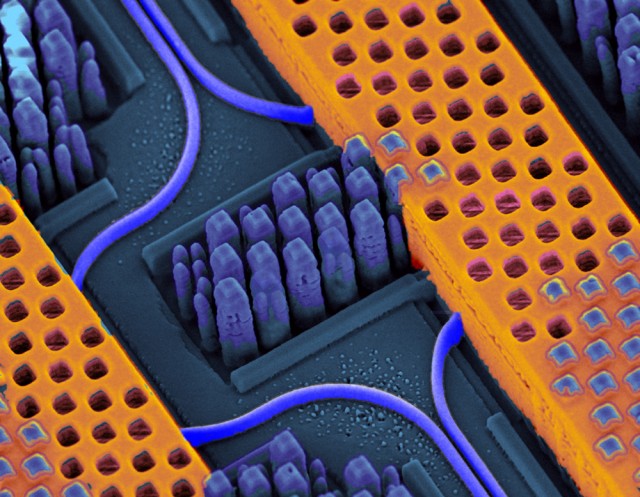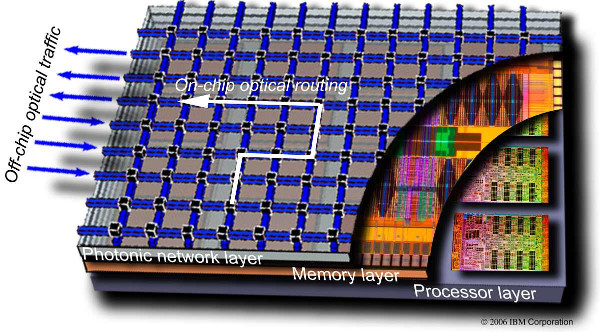IBM has developed a technology for the production of electron-optical chips on conventional 90nm equipment
For over 10 years, IBM has been developing optoelectronic chips that combine conventional semiconductors and optical elements — modulators, waveguides, and multiplexers — on a single chip. If earlier it was only about prototypes created in laboratory conditions, now it has been possible to create a nano-optical transmitter on a practically standard production line using a 90nm process technology with minor modifications. This means that soon the mass production of chips with optical buses can be arranged for communication between the processor and the memory or various processor units.

IBM nano-optical chip under the microscope. Orange areas are copper, blue areas are waveguides.
The prototype contains 50 transmitters operating in parallel, each of them transmits or receives data at a speed of 25 gigabits / sec, the total throughput is 1.25 terabits / sec. This technology can well scale up to pet and exabit speeds, because optical signal transmission is devoid of many electrical problems - signal attenuation and heat generation are much less, higher modulation speed, it is possible to use spectral channel multiplexing.
First of all, such devices will be in demand when creating supercomputers, where the bandwidth of communication channels between computing nodes has long been a bottleneck. Soon, such devices will be used everywhere - the use of almost standard technology allows us to confidently say that the price of chips with optical buses and interfaces will be slightly higher than usual, because all optical elements are created simultaneously with semiconductors, on the same conveyor.
Optics has already supplanted copper over long distances, and is crowding it out in the middle — in data centers, multimedia devices, and the “last mile”. Thanks to cheap optoelectronic elements, it can very soon enter computers and chips. The illustration below shows the concept of using optical communication lines in Network-on-chip (NOC) class systems , which are becoming more and more relevant with the increasing number of processor cores and moving more and more devices on one chip with a processor.


IBM nano-optical chip under the microscope. Orange areas are copper, blue areas are waveguides.
The prototype contains 50 transmitters operating in parallel, each of them transmits or receives data at a speed of 25 gigabits / sec, the total throughput is 1.25 terabits / sec. This technology can well scale up to pet and exabit speeds, because optical signal transmission is devoid of many electrical problems - signal attenuation and heat generation are much less, higher modulation speed, it is possible to use spectral channel multiplexing.
First of all, such devices will be in demand when creating supercomputers, where the bandwidth of communication channels between computing nodes has long been a bottleneck. Soon, such devices will be used everywhere - the use of almost standard technology allows us to confidently say that the price of chips with optical buses and interfaces will be slightly higher than usual, because all optical elements are created simultaneously with semiconductors, on the same conveyor.
Optics has already supplanted copper over long distances, and is crowding it out in the middle — in data centers, multimedia devices, and the “last mile”. Thanks to cheap optoelectronic elements, it can very soon enter computers and chips. The illustration below shows the concept of using optical communication lines in Network-on-chip (NOC) class systems , which are becoming more and more relevant with the increasing number of processor cores and moving more and more devices on one chip with a processor.

